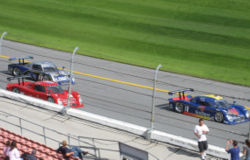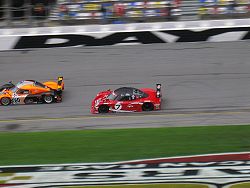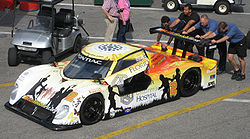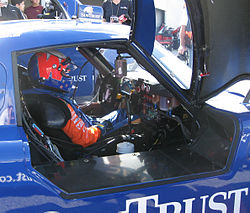- Daytona Prototype
-
A Daytona Prototype is a type of sports prototype racing car developed specifically for the Grand American Road Racing Association's Rolex Sports Car Series as their top class of car, replacing contemporary open cockpit sports cars, specifically Sports Racing Prototypes (SRPs). They are named after the main Rolex Sports Car Series event, the Rolex 24 at Daytona.
Contents
Development
 Daytona Prototypes competing at the 2007 24 Hours of Daytona.
Daytona Prototypes competing at the 2007 24 Hours of Daytona.
 Daytona Prototypes competing at the 2008 24 Hours of Daytona.
Daytona Prototypes competing at the 2008 24 Hours of Daytona.
For the 2003 Rolex Sports Car Series season, the Grand American Road Racing Association (GARRA) announced that they would stop support of their two premiere open cockpit classes, known as SRP-I and SRP-II. These cars, mostly modified from Le Mans Prototypes, were technologically advanced and could reach high speeds, specifically on the Mulsannes Straight at the 24 Hours of Le Mans. However, these same speeds were found to be dangerous at GARRA's premiere track, Daytona International Speedway. The concrete walls of the oval section of the road course that the series runs were dangerous enough on their own, but were also on the parts of the track where cars reached their highest speed. Therefore GARRA decided that they would need to slow down their competitors in order to make Daytona safer.
At the same time, due to the technological advancement of Le Mans prototypes, GARRA decided that they would also lower the overall cost of their prototypes. To do this, they would use closed cockpit chassis made of tube frames, instead of high cost carbon fiber composites. They would also standardize the amount of technology that could go into a car, as well as not allowing teams to develop their cars over a season, instead being forced to stay with the same basic car. This would stop teams from having to spend money on aerodynamic tweaks and technological experimentation, as well as private track testing. To further restrict cost, the series would regulate who could provide chassis and who could provide engines, thus preventing teams from trying a unique chassis or engine that may end up being a failure. Engines specifically would have to be based on a road-legal production unit from a major manufacturer. At the same time, major manufacturers would not be allowed to run Daytona Prototype teams, in order to help keep competition level and costs down.
Combining the low cost elements with the speed and safety elements, the designs for Daytona Prototypes were laid down, with constructors having freedom to develop a car however they wished so long as it fit within the smaller dimensions of a Daytona Prototype over a Le Mans Prototype. These smaller dimensions, especially in length, helped to create a more blunt front end to the car that would slow the cars down, regardless of how much a constructor put into sculpting the design.
Chassis
 A Riley MkXI run by Samax Motorsport.
A Riley MkXI run by Samax Motorsport.
 Driver Wayne Taylor sitting in the cockpit of his Daytona Prototype.
Driver Wayne Taylor sitting in the cockpit of his Daytona Prototype.
In order to help regulate the field and to help keep it level, GARRA only allows a certain number of chassis to be used. At the same time, each approved chassis is allowed to participate for a period of five years before GARRA reselects their approved chassis. Each chassis fits within GARRA's regulations in regards to dimension, but each approved chassis is uniquely different in design.
From 2003 to 2007 seven manufacturers had their chassis approved by GARRA:
- Chase CCE
- Crawford DP03
- Doran JE4
- Fabcar FDSC/03
- Multimatic MDP1 (sometimes badged as the Multimatic Ford Focus)
- Picchio DP2
- Riley MkXI
For 2008, new chassis designs were allowed to be submitted, with several companies purchasing the rights from existing entries. Lola Racing Cars, in association with Krohn Racing, purchased Multimatic's entry for the construction of a new prototype under the name Proto-Auto. Dallara later purchased Doran's entry as well, with assistance from SunTrust Racing.[1]. Cheever Racing purchased Fabcar's license and developed under the Coyote name, with assistance from former manufacturer Picchio.
The new chassis are available from 2008 onward:
GARRA allows for modifications to the bodywork of each Daytona Prototype only in certain areas, most specifically to the rear wing and Gurney flap as well as front dive planes.
Engine
 A Porsche engine installed in a Daytona Prototype.
A Porsche engine installed in a Daytona Prototype.
As well as the chassis, the engines used are also standardized and regulated. Unlike chassis, engines must come from a major production car manufacturer, using the block from an engine used on a production car. However, these engines can have their displacements modified in order to equalize the field. For 2007, all engines will also be required to use standardized ECUs in order to better regulate engine performance.
The following engines are currently approved by GARRA:
- BMW 5.0 L V8
- Ford 5.0 L V8
- Infiniti 4.35 L V8
- Lexus 5.0 L V8 (can also be branded as Toyota)
- Porsche 3.99 L Flat-6
- Porsche 5.0 L V8 (approved in late 2007)
- Pontiac 5.0 L V8 (can also be branded as Chevrolet or Cadillac)
- Honda 3.9 L V6
Each engine also has specific restrictions on what can be modified beyond stock parts, as well as restrictions on intake and exhaust dimensions, RPM, and various technical details.
During the 2007 season, a second Porsche engine was approved by Grand Am. The 5.0L V8 unit is not actually constructed by Porsche, but is based on the V8 engine used in the Porsche Cayenne, built by Lozano Bros. Porting.
Specifications
- Engine displacement: 5.0 L (302 in³) Maximum
- Transmission: 4.5 L (275 in³) displacement and above - 5 forward gears (maximum)
4.5 L (275 in³) displacement and below - 6 forward gears (maximum) manual or sequential manual transmission - Weight: 4.0 L (244 in³) displacement and above-2,275 lb (1,032 kg)
Below 4.0 L (244 in³)-2,225 lb (1,010 kg) - Power Output: 500 hp (370kW)
- Fuel: 100 octane unleaded gasoline
- Fuel capacity: 24 U.S. gallons (91 liters)
- Fuel delivery: Fuel injection
- Aspiration: Naturally aspirated
- Steering: Power, rack and pinion
History
Debuting in the 2003 season, specifically at the Rolex 24 at Daytona, six Daytona Prototypes initially ran: A Fabcar-Toyota, a Picchio-BMW, a Doran-Chevrolet, two Fabcar-Porsches, and a Multimatic-Ford. In qualifying, a Chevrolet Corvette and a Ford Mustang, both from the GTS class, took the top two spots on the grid, while the leading Daytona Protype was the Multimatic-Ford. Grand-Am however reversed "the first three rows of the grid for the Daytona Prototypes, regardless of their qualifying times," to ensure the Daytona Prototypes started at the front of the field.[1] The Daytona Prototypes also failed to even take the overall pole position from heavily restricted SRP prototypes. In the race itself, only two DPs managed to finish, far behind a much lower Grand Touring class car. However, after the teething problems were worked out, the cars began to take overall victories as the season progressed.
For 2004, the SRP classes were finally cancelled, and the number of DPs grew, with 17 appearing at the season opener at Daytona where they managed to take the overall win. By 2006, thanks to the low cost of the design, the number of DPs at some races grew to above thirty entrants, allowing for full fields and close racing.
GARRA plans to continue using the Daytona Prototype in the forseable future, with new chassis designs being allowed into the series in 2008.
Since 2006, DP cars were permitted to compete in Japan's Super GT in the secondary GT300 class with outstanding results, one entrant, the Mooncraft Shiden lost out to an RE Amemiya RX-7 (although tied for points) in the drivers' title and again to a MR-S, but took the team title in 2007.
References
- ^ 911 & Porsche World, March 2003
- Cotton, Michael (March 2004). "Michael Cotton's Porsche month". 911 & Porsche World: 35.
External links
Categories:- Sports prototypes
- Sports car racing
- Grand-Am
Wikimedia Foundation. 2010.










